Underwater Drag Reduction Failure of Superhydrophobic Surface Caused by Adhering Spherical Air Bubbles
Abstract
:1. Introduction
2. Materials and Methods
2.1. Sample Preparation
2.2. Hydrodynamic Experiment
2.3. Characterization
2.4. Numerical Method
3. Results and Discussion
3.1. The Result of Water Tunnel Experiment
3.2. The Result of Towing Tank Experiment
3.3. The Results of Numerical Simulation
4. Conclusions
Author Contributions
Funding
Institutional Review Board Statement
Informed Consent Statement
Data Availability Statement
Conflicts of Interest
Abbreviations
| AWI | Air–water interface |
| ILIM | Ideal lubricant interface model |
| HSNP | Hydrophobic silica nanoparticle |
| Drag reduction rate |
References
- Zhang, X.; Zhang, D.Y.; Pan, J.F.; Li, X.; Chen, H.W. Controllable Adjustment of Bio-Replicated Shark Skin Drag Reduction Riblets. Appl. Mech. Mater. 2013, 461, 677–680. [Google Scholar] [CrossRef]
- Walsh, M.J.; Weinstein, L.M. Drag and heat-transfer characteristics of small longitudinally ribbed surfaces. AIAA J. 1979, 17, 770–771. [Google Scholar] [CrossRef]
- Choi, K.S.; Clayton, B.R. The mechanism of turbulent drag reduction with wall oscillation. Int. J. Heat Fluid Flow 2001, 22, 1–9. [Google Scholar] [CrossRef]
- Gatti, D.; Guttler, A.; Frohnapfel, B.; Tropea, C. Experimental assessment of spanwise-oscillating dielectric electroactive surfaces for turbulent drag reduction in an air channel flow. Exp. Fluids 2015, 56, 110. [Google Scholar] [CrossRef]
- Rajappan, A.; McKinley, G.H. Cooperative drag reduction in turbulent flows using polymer additives and superhydrophobic walls. Phys. Rev. Fluids 2020, 5, 114601. [Google Scholar] [CrossRef]
- Fichman, M.; Hetsroni, G. Electrokinetic aspects of turbulent drag reduction in surfactant solutions. Phys. Fluids 2004, 16, 4346–4352. [Google Scholar] [CrossRef]
- Bidkar, R.A.; Leblanc, L.; Kulkarni, A.J.; Bahadur, V.; Ceccio, S.L.; Perlin, M. Skin-friction drag reduction in the turbulent regime using random-textured hydrophobic surfaces. Phys. Fluids 2014, 26, 18. [Google Scholar] [CrossRef]
- Xu, M.; Yu, N.; Kim, J.; Kim, C.J.C. Superhydrophobic drag reduction in high-speed towing tank. J. Fluid Mech. 2020, 908, A6. [Google Scholar] [CrossRef]
- Kim, H.N.; Kim, S.J.; Choi, W.; Sung, H.J.; Lee, S.J. Depletion of lubricant impregnated in a cavity of lubricant-infused surface. Phys. Fluids 2021, 33, 022005. [Google Scholar] [CrossRef]
- Yao, W.H.; Wu, L.; Sun, L.D.; Jiang, B.; Pan, F.S. Recent developments in slippery liquid-infused porous surface. Prog. Org. Coat. 2022, 166, 106806. [Google Scholar] [CrossRef]
- Tong, W.; Xiong, D.S.; Zhou, H.J. TMES-modified SiO2 matrix non-fluorinated superhydrophobic coating for long-term corrosion resistance of aluminium alloy. Ceram. Int. 2020, 46, 1211–1215. [Google Scholar] [CrossRef]
- Guo, D.Y.; Chen, J.H.; Wen, L.F.; Wang, P.; Xu, S.P.; Cheng, J.; Wen, X.F.; Wang, S.F.; Huang, C.Y.; Pi, P.H. A superhydrophobic polyacrylate film with good durability fabricated via spray coating. J. Mater. Sci. 2018, 53, 15390–15400. [Google Scholar] [CrossRef]
- Zhang, Y.; Wang, T.; Lv, Y.J. Durable Biomimetic Two-Tier Structured Superhydrophobic Surface with Ultralow Adhesion and Effective Antipollution Property. Langmuir 2023, 39, 2548–2557. [Google Scholar] [CrossRef] [PubMed]
- Hu, Y.M.; Zhu, Y.; Zhou, W.; Wang, H.; Yi, J.H.; Xin, S.S.; He, W.J.; Shen, T. Dip-coating for dodecylphosphonic acid derivatization on aluminum surfaces: An easy approach to superhydrophobicity. J. Coat. Technol. Res. 2016, 13, 115–121. [Google Scholar] [CrossRef]
- Celik, N.; Torun, I.; Ruzi, M.; Esidir, A.; Onses, M.S. Fabrication of robust superhydrophobic surfaces by one-step spray coating: Evaporation driven self-assembly of wax and nanoparticles into hierarchical structures. Chem. Eng. J. 2020, 396, 125230. [Google Scholar] [CrossRef]
- Zhang, L.S.; Zhou, A.G.; Sun, B.R.; Chen, K.S.; Yu, H.Z. Functional and versatile superhydrophobic coatings via stoichiometric silanization. Nat. Commun. 2021, 12, 982. [Google Scholar] [CrossRef]
- Chen, X.Y.; Yuan, J.H.; Huang, J.; Ren, K.; Liu, Y.; Lu, S.Y.; Li, H. Large-scale fabrication of superhydrophobic polyurethane/nano-Al2O3 coatings by suspension flame spraying for anti-corrosion applications. Appl. Surf. Sci. 2014, 311, 864–869. [Google Scholar] [CrossRef]
- Barbier, C.; Jenner, E.; D’Urso, B. Drag reduction with superhydrophobic riblets. In Proceedings of the ASME International Mechanical Engineering Congress and Exposition, Houston, TX, USA, 9–15 November 2012; pp. 199–205. [Google Scholar]
- Chen, Q.D.; Duan, J.; Hou, Z.B.; Hou, G.X.; Deng, L.M. Effect of the surface pattern on the drag property of the superhydrophobic surface. Phys. Fluids 2022, 34, 114113. [Google Scholar] [CrossRef]
- Saranadhi, D.; Chen, D.Y.; Kleingartner, J.A.; Srinivasan, S.; Cohen, R.E.; McKinley, G.H. Sustained drag reduction in a turbulent flow using a low-temperature Leidenfrost surface. Sci. Adv. 2016, 2, 9. [Google Scholar] [CrossRef]
- Aljallis, E.; Sarshar, M.A.; Datla, R.; Sikka, V.; Jones, A.; Choi, C.H. Experimental study of skin friction drag reduction on superhydrophobic flat plates in high Reynolds number boundary layer flow. Phys. Fluids 2013, 25, 14. [Google Scholar] [CrossRef]
- Gose, J.W.; Golovin, K.; Boban, M.; Mabry, J.M.; Tuteja, A.; Perlin, M.; Ceccio, S.L. Characterization of superhydrophobic surfaces for drag reduction in turbulent flow. J. Fluid Mech. 2018, 845, 560–580. [Google Scholar] [CrossRef]
- Ling, H.; Srinivasan, S.; Golovin, K.; McKinley, G.H.; Tuteja, A.; Katz, J. High-resolution velocity measurement in the inner part of turbulent boundary layers over super-hydrophobic surfaces. J. Fluid Mech. 2016, 801, 670–703. [Google Scholar] [CrossRef]
- Abu Rowin, W.; Ghaemi, S. Streamwise and spanwise slip over a superhydrophobic surface. J. Fluid Mech. 2019, 870, 1127–1157. [Google Scholar] [CrossRef]
- Abu Rowin, W.; Ghaemi, S. Effect of Reynolds number on turbulent channel flow over a superhydrophobic surface. Phys. Fluids 2020, 32, 075105. [Google Scholar] [CrossRef]
- Reholon, D.; Ghaemi, S. Plastron morphology and drag of a superhydrophobic surface in turbulent regime. Phys. Rev. Fluids 2018, 3, 104003. [Google Scholar] [CrossRef]
- Park, H.; Sun, G.; Kim, C.J. Superhydrophobic turbulent drag reduction as a function of surface grating parameters. J. Fluid Mech. 2014, 747, 722–734. [Google Scholar] [CrossRef]
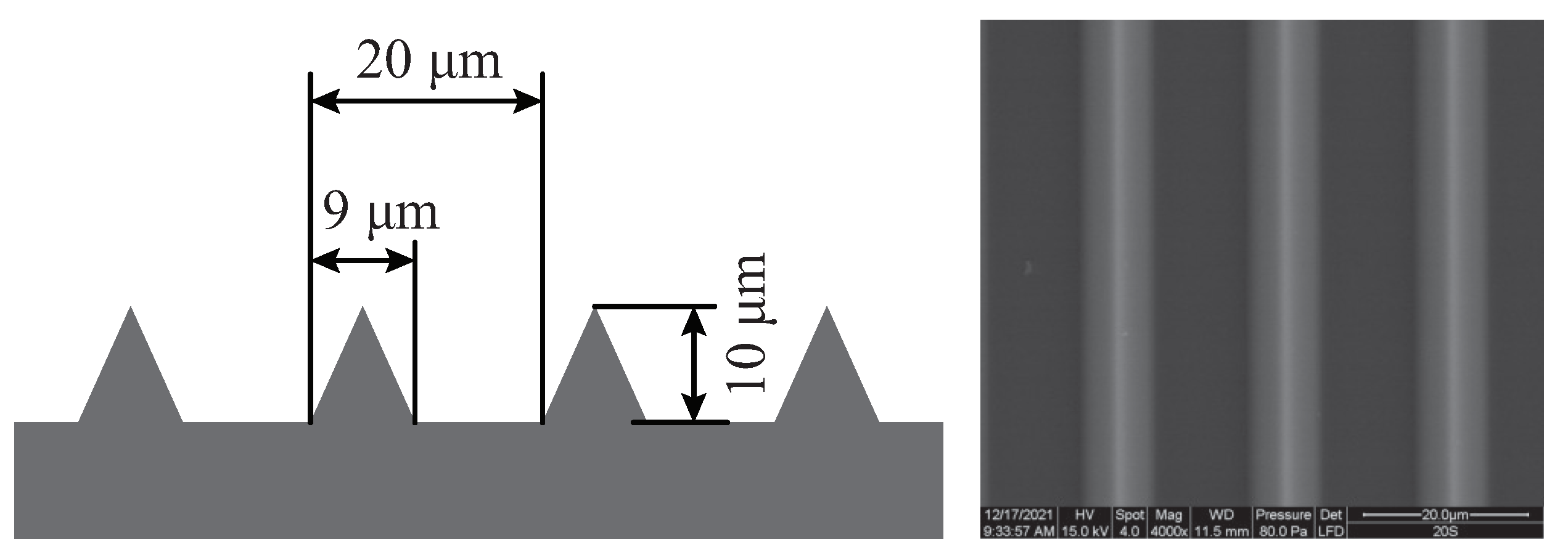

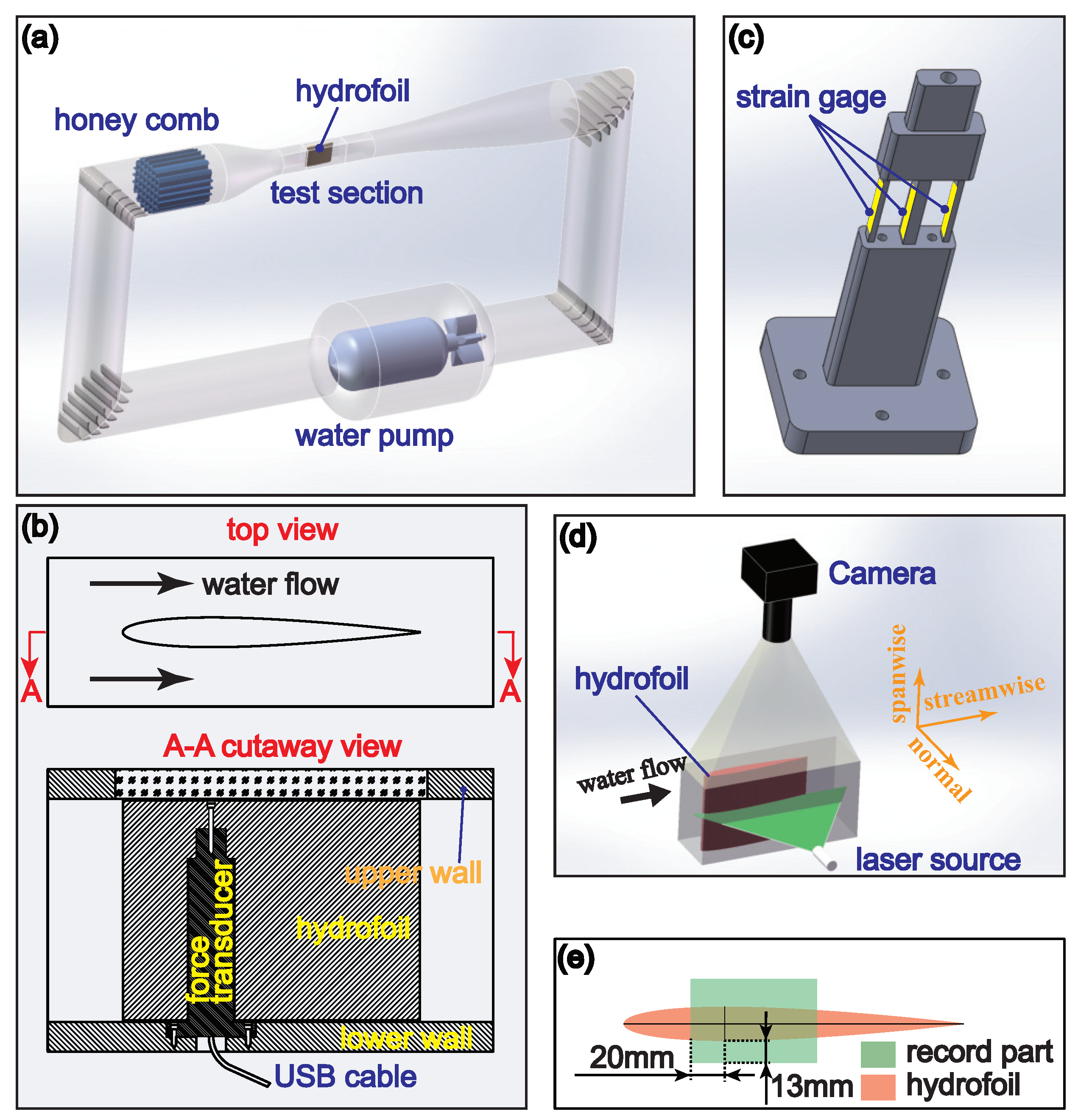

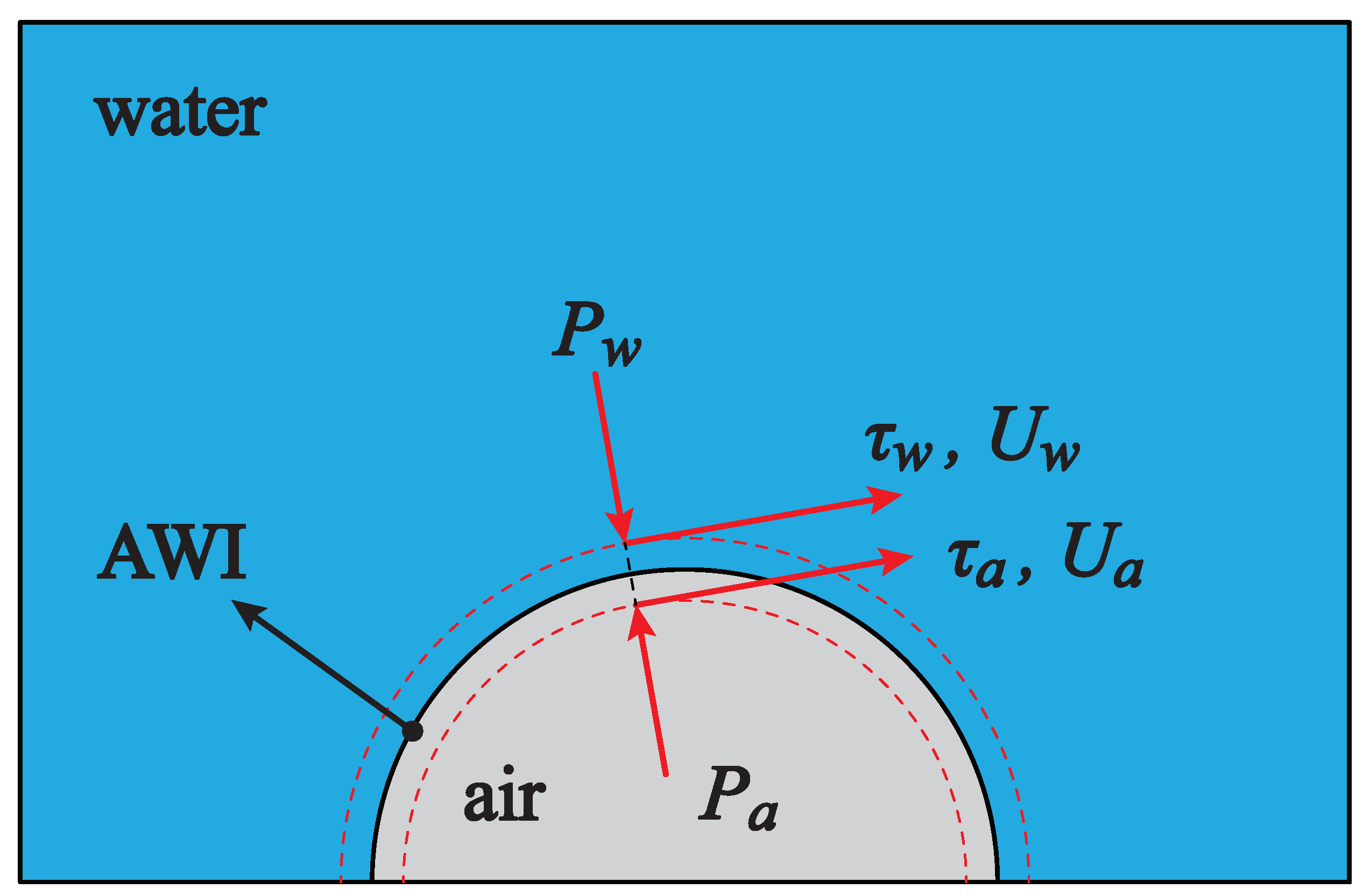

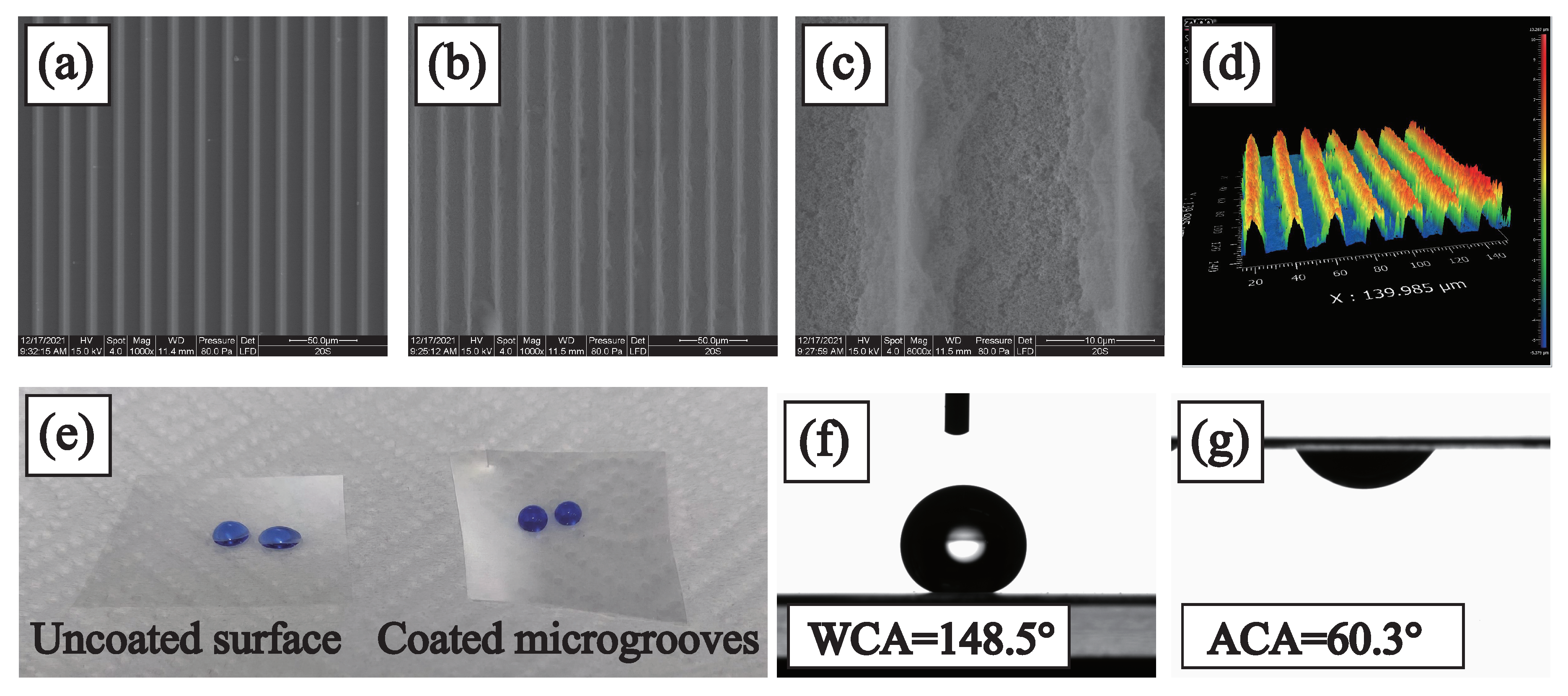




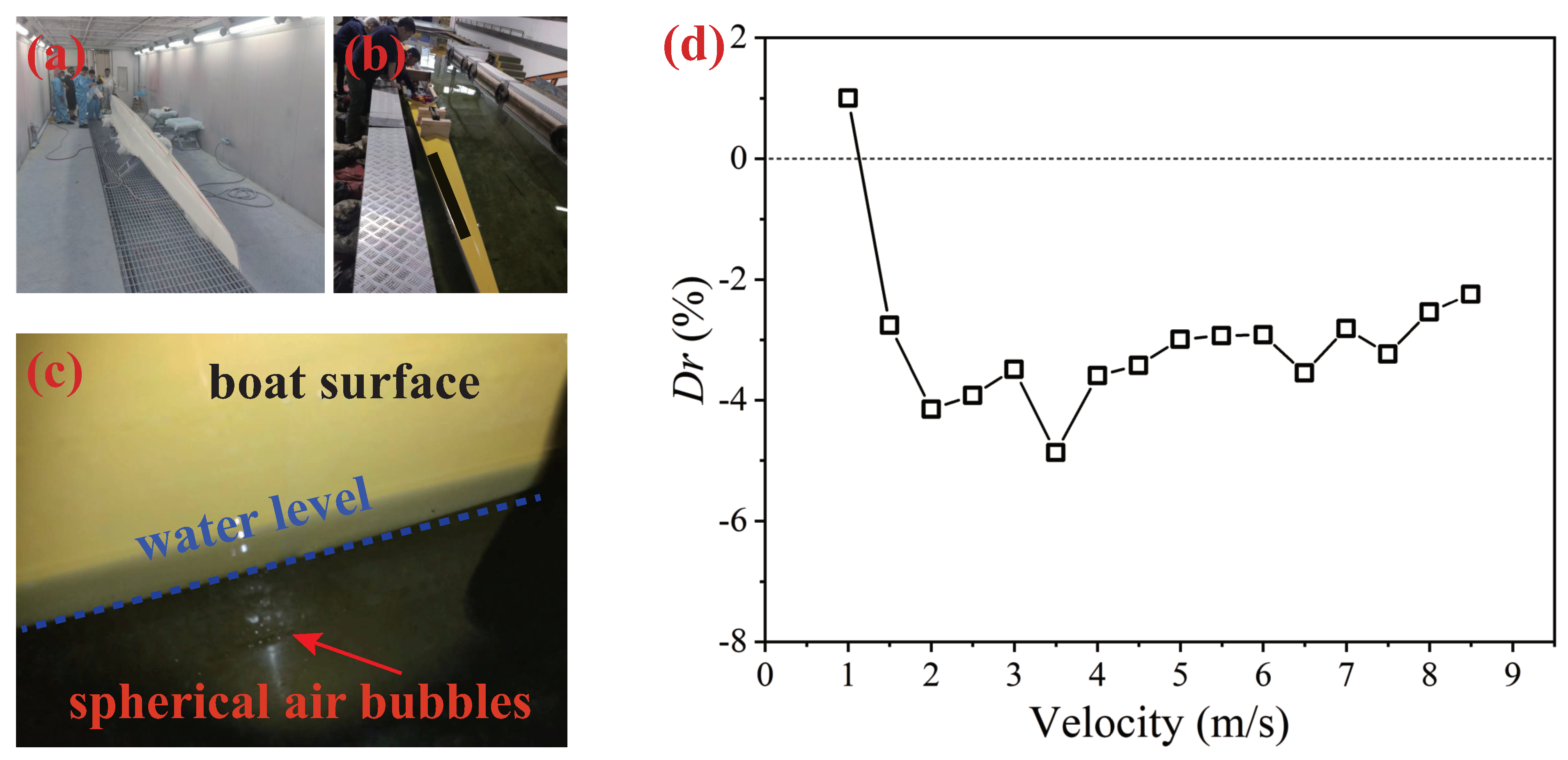
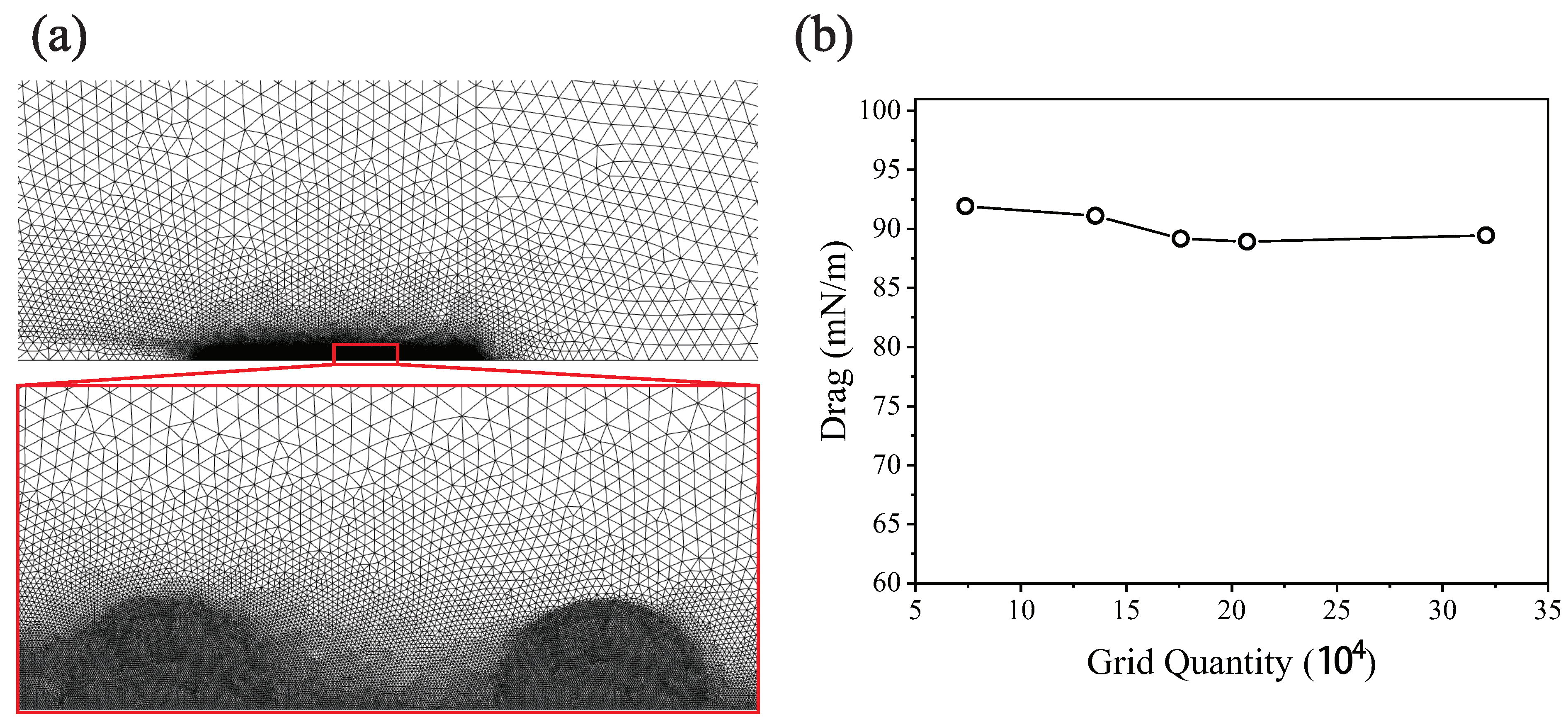
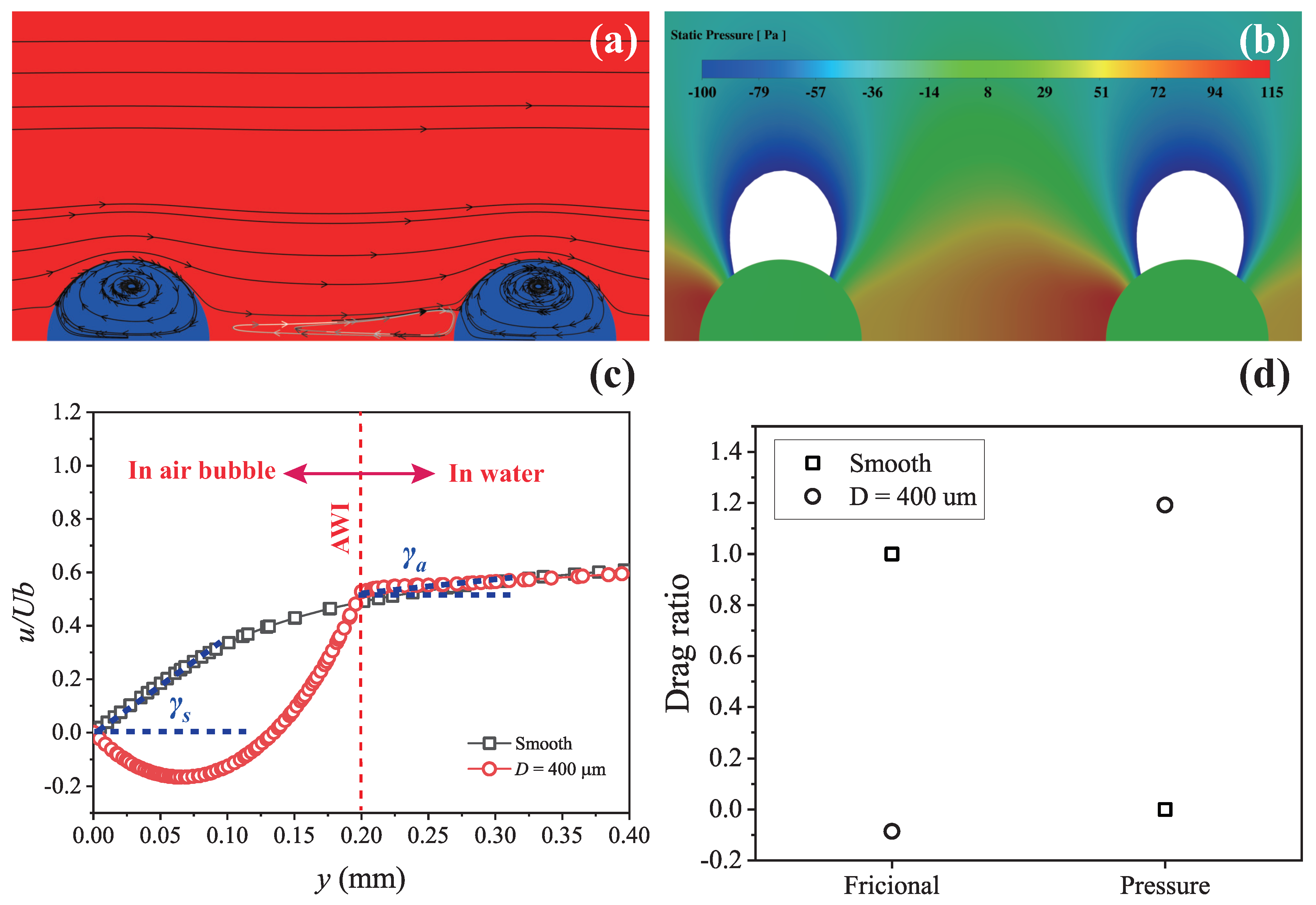
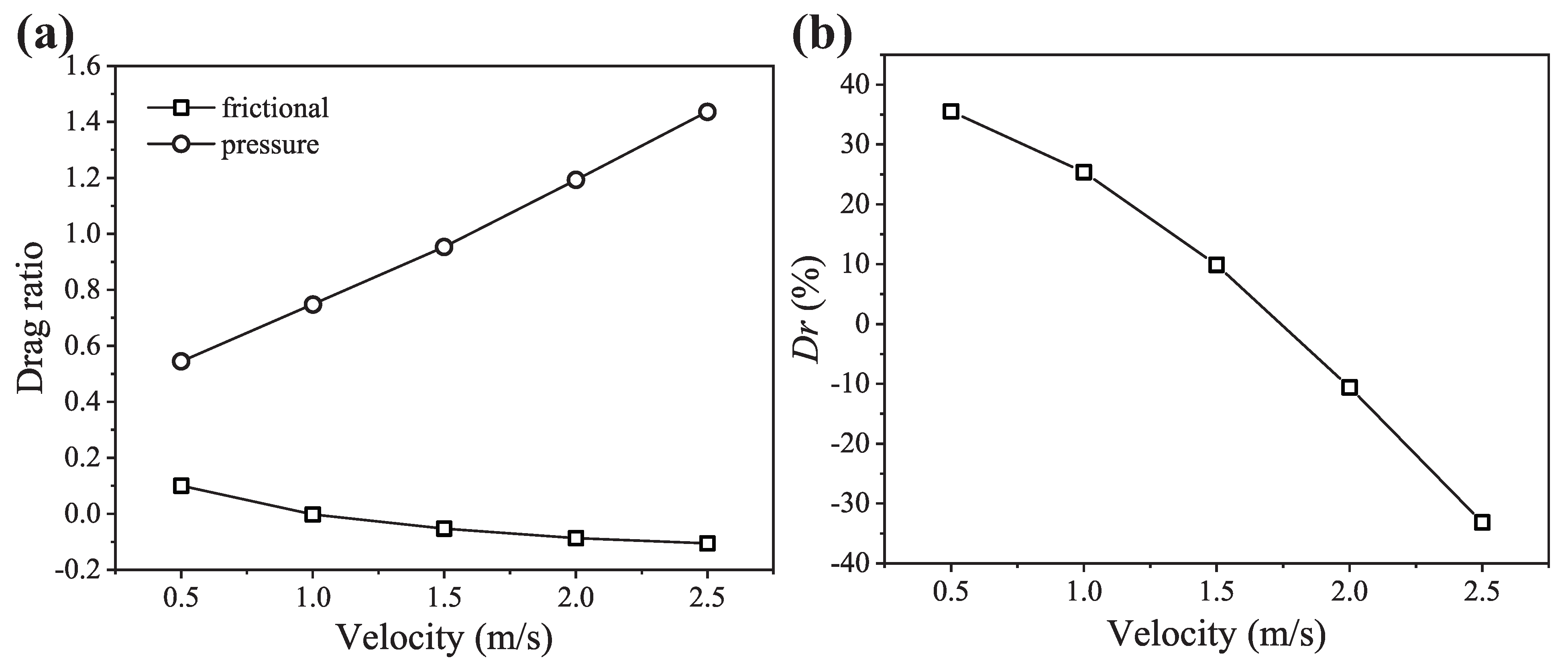
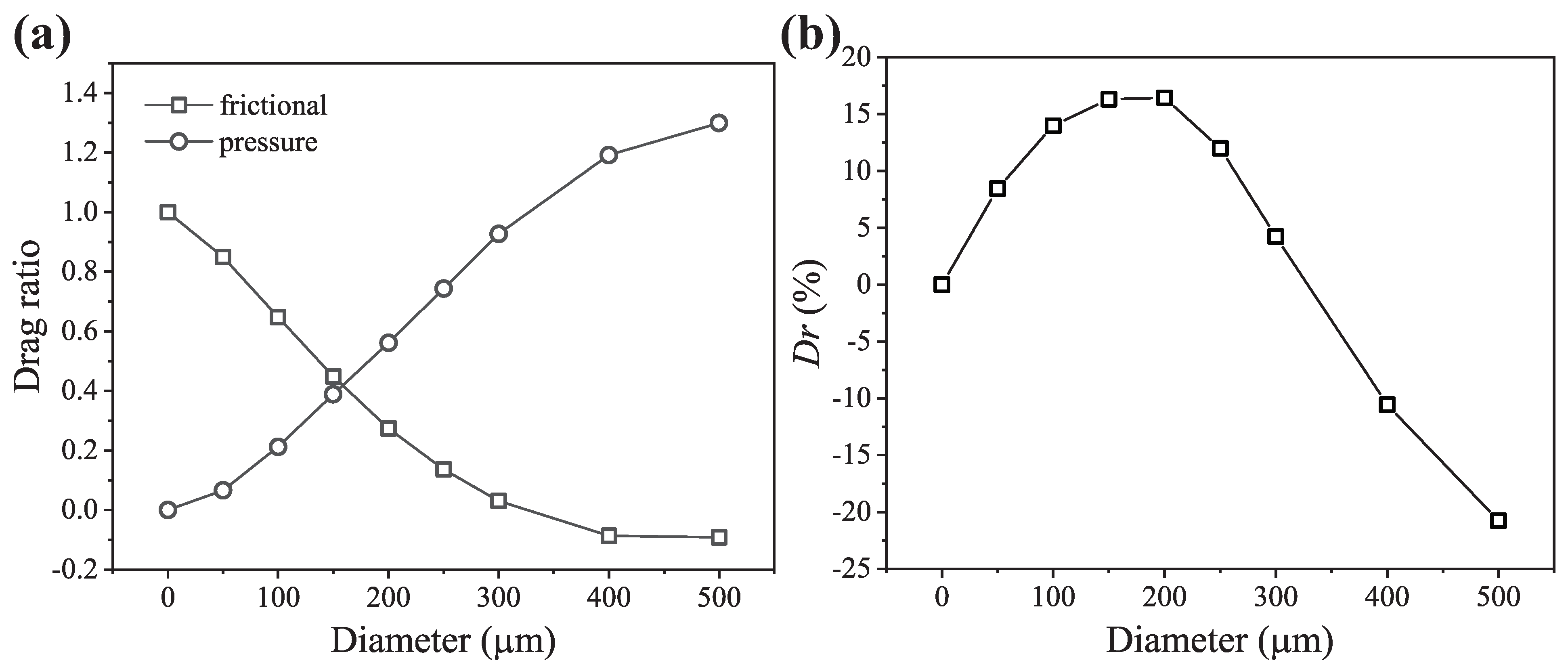
Disclaimer/Publisher’s Note: The statements, opinions and data contained in all publications are solely those of the individual author(s) and contributor(s) and not of MDPI and/or the editor(s). MDPI and/or the editor(s) disclaim responsibility for any injury to people or property resulting from any ideas, methods, instructions or products referred to in the content. |
© 2024 by the authors. Licensee MDPI, Basel, Switzerland. This article is an open access article distributed under the terms and conditions of the Creative Commons Attribution (CC BY) license (https://creativecommons.org/licenses/by/4.0/).
Share and Cite
Nie, Y.; Weng, D.; Wang, J. Underwater Drag Reduction Failure of Superhydrophobic Surface Caused by Adhering Spherical Air Bubbles. J. Mar. Sci. Eng. 2024, 12, 2170. https://doi.org/10.3390/jmse12122170
Nie Y, Weng D, Wang J. Underwater Drag Reduction Failure of Superhydrophobic Surface Caused by Adhering Spherical Air Bubbles. Journal of Marine Science and Engineering. 2024; 12(12):2170. https://doi.org/10.3390/jmse12122170
Chicago/Turabian StyleNie, You, Ding Weng, and Jiadao Wang. 2024. "Underwater Drag Reduction Failure of Superhydrophobic Surface Caused by Adhering Spherical Air Bubbles" Journal of Marine Science and Engineering 12, no. 12: 2170. https://doi.org/10.3390/jmse12122170
APA StyleNie, Y., Weng, D., & Wang, J. (2024). Underwater Drag Reduction Failure of Superhydrophobic Surface Caused by Adhering Spherical Air Bubbles. Journal of Marine Science and Engineering, 12(12), 2170. https://doi.org/10.3390/jmse12122170




